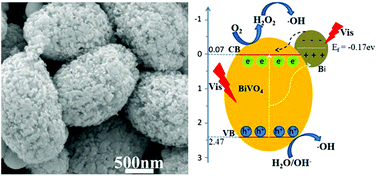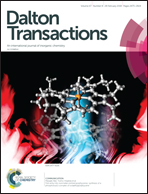Facile synthesis of Bi/BiVO4 composite ellipsoids with high photocatalytic activity†
Abstract
BiVO4-based composites have been extensively investigated as promising photocatalysts due to their strong visible-light absorption. In this work, novel Bi/BiVO4 composites with excellent photocatalytic performance were firstly fabricated via a simple hydrothermal method, using BiVO4 as a self-sacrificing template and N2H4·H2O as a reductant. In the hydrothermal process, partial BiVO4 was reduced to form metallic Bi nanoparticles, which were deposited on the surface of BiVO4. The Bi content in the Bi/BiVO4 composites could be easily tuned by controlling the concentration of the N2H4·H2O solution. The photocatalytic performance of the Bi/BiVO4 composites was examined by studying the photodecomposition of RhB under visible-light illumination. The experimental results revealed that the Bi/BiVO4 composites exhibit high visible-light photocatalytic activity for the photodegradation of RhB compared with that of pure BiVO4. This enhanced photocatalytic activity likely originates from the strong visible-light absorption and high separation efficiency of photogenerated electron–hole pairs by Bi nanoparticles. This work presents a new approach for the development of Bi/BiVO4 composite photocatalysts with high activity and stability.



 Please wait while we load your content...
Please wait while we load your content...